Matter Around Us Notes 7th Science Lesson 3 Notes in English
7th Science Lesson 3 Notes in English
3] Matter Around Us
Introduction:
- We knew that everything we see around, that occupy space and have mass, is called matter. Heat, light and sound occupies space, but does not have mass.
Atoms
- The graphite refill used in pencil is made up of element called Carbon.
- We can break the graphite into smaller and smaller pieces. In fact, if we have an even finer knife, we can break it even smaller.
- If keep cutting the minuscule graphite into smaller and smaller particle, we will reach a point where we reach smallest constituent of graphite- carbon atom.
- If we break that carbon atom apart, then it will no longer exhibit the properties of carbon.
- The smallest unit of an element that exhibits the properties of the element is called as ‘atom’. All the matter is composed of tiny particles called atom.
- Water, rice, in short everything we see around is made up of atoms.
- An atom is the basic unit of a matter.
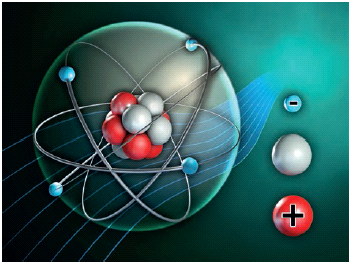
Structure of an atom
- Even with the best of optical microscope we cannot see atoms.
- However there are advanced instruments that help us to image the atoms on the surface of a material.
- For example the following figure shows an image of the surface of silicon.
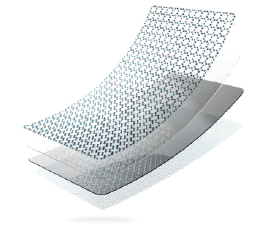
An image of the surface of Silicon
Molecules
- When an atom combines with another atom (or atoms) and forms a compound it is called as molecule.
- A molecule is made up of two or more atoms chemically combined.
- Oxygen gas in the air that we breathe is made up of two oxygen atoms chemically combined.
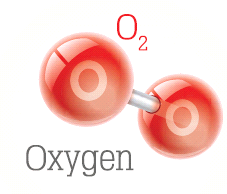
- Ozone is a substance that is made up of three oxygen atoms chemically combined.

- An atom of oxygen (O) and two atoms of hydrogen (H2) combine to form a molecule of water (H2O).
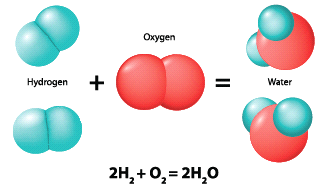
Formation of water molecule
- Molecules also exhibit properties of matter and have individual existence. A molecule can be formed by the same or different kinds of atoms.
Molecules can be classified as follow:
- A molecule which contains only one atom is called monatomic molecule (inert gases)
- A molecule which contains two atoms is called diatomic molecule (oxygen, nitric oxide, hydrogen, etc.)
- A molecule containing three atoms is called a triatomic molecule (ozone, sulphur dioxide, carbon dioxide, etc.)
- A molecule containing more than 3 atoms are known as polyatomic molecule (phosphate, sulphur, etc.)
Molecules of Elements
- A molecule of an element consists of a fixed number of one types of atom chemically combined.
- The table below shows gases that are made up of two atoms of the same type of element.
Molecules of Compounds
- Molecule of a compound consists of a fixed number of different types of atoms chemically combined.
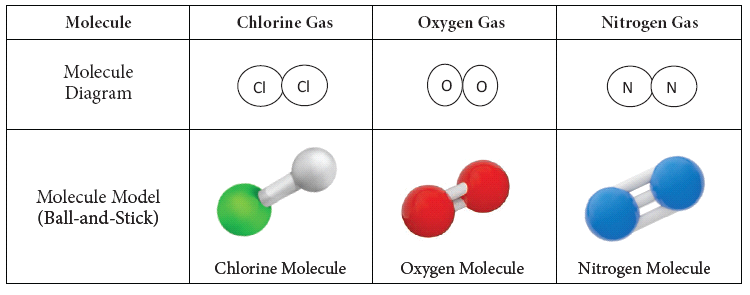
For example, let us look at the model of a water molecule below:
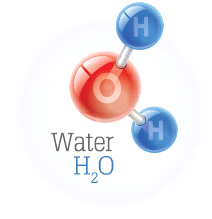
Model of molecular water
- Each molecule of water consists of one oxygen atom and two hydrogen atoms.
- This ratio of oxygen and hydrogen atom remains fixed whether water is in liquid, solid or gaseous state.
- This principle applies to the molecules of all compounds.
Molecules of some compounds
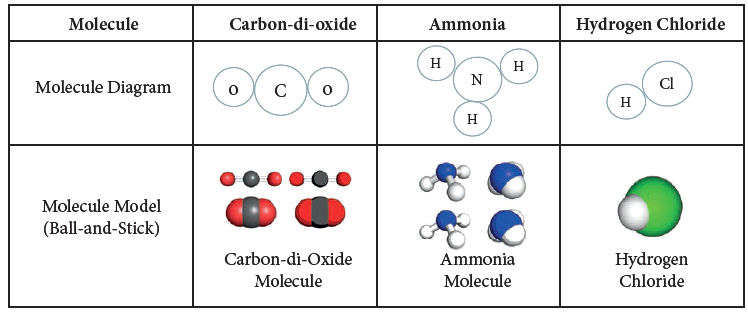
Classification of Matter
- Matter is classified into two broad categories, namely, pure substances and mixtures. Pure substances are further divided into categories as elements and compounds.
Elements
- Matter in its simplest form is called an element.
- We are using many elements in our daily life. The common salt is consisting of elements of Sodium and Chlorine.
- Water consists of Hydrogen and Oxygen. Magnesium and Phosphorus used for making crackers.
- Sulphur is used as manure in agriculture.
- Gallium is used for making mobile phones and silicon is used for making computer chips.
- There are 118 known elements till date. 94 of these elements occur naturally while 24 elements have been created artificially in the laboratory.
Classification of Elements
- We can classify the elements broadly into metals, non-metals and metalloids based upon their chemical properties.
Metals
- We have tools, utensils and jewelry made from silver, copper, iron, gold, Aluminum.
- Using pressure like hammering or rolling we can deform these materials into various shapes.
- Such elements that are malleable (a material may be flattened into thin sheets or various shapes) is called as metals.
- Metals are generally hard and shiny elements.
- Sodium is one of the exceptions as it is soft.
- All metals, except mercury are solids at room temperature. Mercury is the only metal that is liquid at room temperature.
- Metals are malleable, can be bent or beaten into sheets. They can be drawn into wires. They are good conductors of heat and electricity.
- Copper, Lead, tin, nickel, iron, zinc, gold, magnesium and calcium are examples of metals.
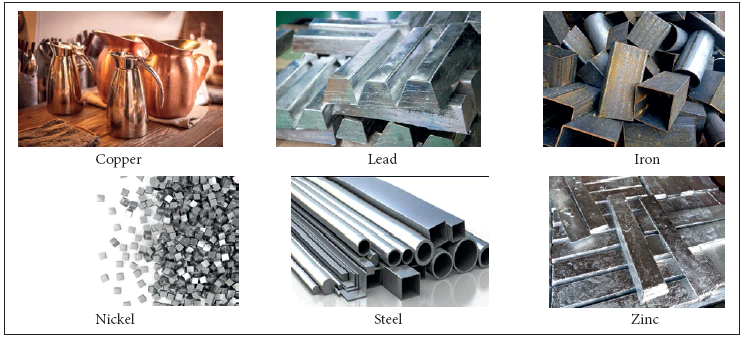
Non-Metals
- Non-metals are generally dull and soft. However, diamond is shiny and also the hardest natural substance on earth.
- Non-metals can be gases, solids, liquids. Non metals such as oxygen, hydrogen and chlorine are gases at room temperature.
- Non metals such as carbon, iodine, sulphur and phosphorus are solids at room temperature.
- Bromine is the only non-metal that is liquid at room temperature.
- Non-metals are poor conductors of heat and electricity. However, graphite (a form of the non-metal carbon) is a good conductor of electricity.

The difference between metals and non-metals

Metalloids
- Metalloids exhibit the properties of both metals and non metals. Silicon, arsenic, antimony, and boron are some examples of metalloids.
Compounds
- A compound is a pure substance that is formed when the atoms of two or more elements combine chemically in definite proportions.
- Compounds exhibit properties entirely different from the properties of their constituent elements.
- For example, the atoms of the elements hydrogen and oxygen combine chemically in a fixed ratio to form the compound water.
- However, water does not have the exact same properties as hydrogen and oxygen.
- For example, at room temperature water exist as liquid while hydrogen and oxygen exist as gases. Also, oxygen supports fire whereas water is used as a fire extinguisher.
- Similarly, common salt (sodium chloride) is a compound made up of elements sodium and chlorine.
- It is used in our food, whereas sodium and chlorine are poison, are both unsafe for consumption.
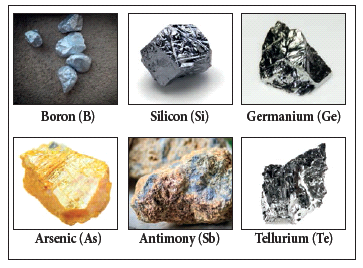
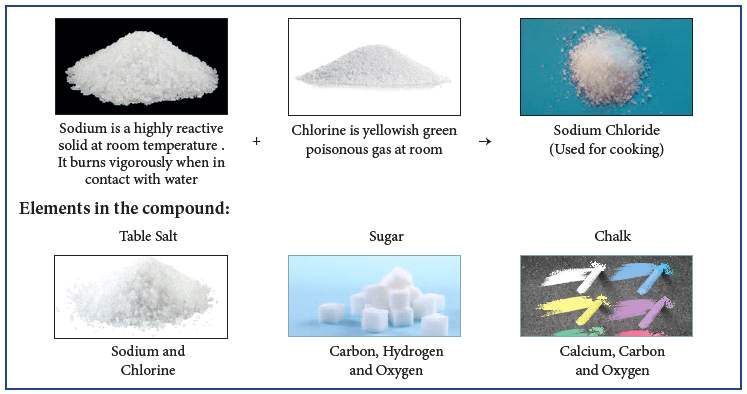
Properties of Compounds
- A compound is formed only when the constituent elements combine in a fixed proportion.
- The properties of a compound are different from those of its constituent elements.
- A compound cannot be broken down by physical methods. This is because a compound is made up of different elements that are chemically combined. Sodium chloride cannot be separated by physical methods such as filtration.
- A compound can be separated into its constituent elements by chemical methods only.
Difference between an element and a compound

Symbol of an element
- A symbol is an abbreviation or short representation of a chemical element. There is a unique symbol for each element.
- It represents one atom of the element.
- The symbol is usually derived from the name of the element, which is either in English or Latin.
- These symbols are allocated by the International Union of Pure and Applied Chemistry (IUPAC).
- Dalton was the first scientist to use the symbols for elements in a very specific sense.
- When he used a symbol for an element he also meant a definite quantity of that element, that is, one atom of that element.
- Berzelius suggested that the symbols of elements be made from one or two letters of the name of the element.
Symbols for some elements as proposed by Dalton
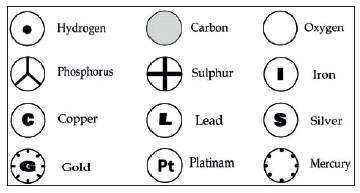
The following rules are followed while assigning symbol to an elements:
- Chemical symbols usually consist of one or two letters
- The symbols of most elements correspond to the first letter (which is capitalized) of their English name. For example, the symbol for oxygen is “O” and that for hydrogen is “H”.
Elements represented by single letter symbols

- When there is more than one element that begins with the same letter, their symbols take two letters.
- The first letter is capitalized while the second letter has a lower case.
- For example, the names of both hydrogen and helium begin with H. So, hydrogen is represented by the symbol H and Helium by He.
- Similarly, the symbol for carbon is C while the symbols for calcium, chlorine and chromium are Ca, Cl and Cr, respectively.
Elements represented by symbols of two letters

- The symbols for some elements are derived from their Latin names.
- For example, the symbol for gold is Au after its Latin name Aurum. Similarly, the symbol for copper is Cu after its Latin name Cuprum.

Chemical Formulae
- Often we hear that water is H2O.
- This is the chemical formula for water molecule. This means that each molecule of water has two hydrogen atoms combined with one oxygen atom.
- A chemical formula is a symbolic representation of one molecule of an element or a compound.
- It provides information about the elements present in the molecule and the number of atoms of each element.
- Can you guess the types of atoms and number of each of the atoms in NaCl,
- The chemical formula tells us the types of atoms and the number of each type of atom in one molecule of substance.
Common compounds and their chemical formula
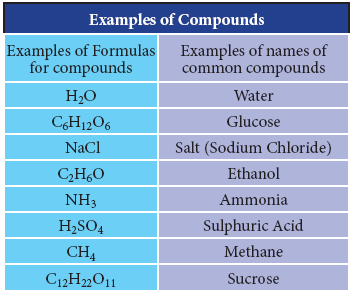
Atomicity
- In chemistry we usually understand atomicity to imply the total number of atoms present in one molecule of an element, compound or a substance.
- Let we see how to calculate the atomicity of elements.
- For example, Oxygen exists as a diatomic molecule which means that a molecule of oxygen contains two atoms hence its atomicity is 2.

- Similarly phosphorus (P4) molecule contains 4 atoms; a sulphur (S8) molecule contains 8 sulphur atoms. Hence their atomicity is 4 and 8 respectively.
- For molecule containing more than one types of atoms, simply count the number of each atom and that would be its atomicity.
- For example, a molecule of sulphuric acid (H2SO4) consists of 2 hydrogen atom, 1 sulphur atom and 4 oxygen atoms. Hence e its atomicity is 2+1+4=7.
- One molecule of water (H2O) contains two atoms of hydrogen and one atom of oxygen, the atomicity of water is three.
Atomicity of some elements
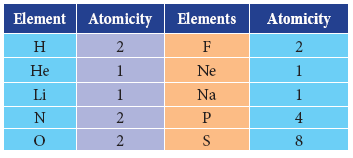
Elements in human Body
- Nearly 99% of the mass of our human body consists of just 6 chemical elements: oxygen, carbon, hydrogen, nitrogen, calcium, and phosphorus.
- Another 5 elements make up most of the least percentage point: potassium, sulphur, sodium, chlorine, and magnesium.
Elements in air
- Air is a mixture of gases.
- The molecules of two different elements, nitrogen and oxygen, make up about 99% of the air.
- The rest includes small amounts of argon and carbon dioxide. (Other gases such as neon, helium, and methane are present in trace amounts.) Oxygen is the life- giving element in the air.
Effect of temperature on Solid, Liquid and Gas
What happens to matter during heating?
- The following are models of particles in solids during heating. These models can be modified to represent heating in Solids, Liquids and Gas.
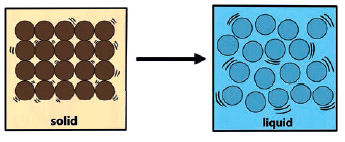
- When solid is heated, the particles gain energy and vibrate vigorously. The particles move slightly further apart from one another.
- This causes the volume of matter to increase. This process is called expansion. The matter begun to expand when heated.
- The volume increases due to the greater distance between the particles. But the size of the particles remains in same size.
- During heating or expansion, the mass of matter does not change. This is explained in the following way.
- During heating, the distance between the particles of the iron locks change. Mass is conserved when matter expands.
- Although the volume of the matter changes, the size and number of the particles of matter do not change.
- Hence, during heating, the mass of a matter is conserved. For example, in an iron lock the distance between the iron particles increases when they gain enough heat.
- However, the number of iron particles does not change. Hence the mass of the iron lock is conserved.
- The melting of ice is an example of a change in the states of matter. The change in the states of matter occurs during melting, boiling and freezing and condensation.
- When the particles possess enough energy, they overcome the strong forces of attraction between one another.
- The particles break free from one another and move randomly. For example, when solid ice is heated to 00C, it melts to become liquids water.
- In the same way, liquid water is heated to 1000C, it boils to become steam.

More to know:
- The most abundant type of atom in the universe is the hydrogen atom. Nearly 74% of the atoms in the universe are hydrogen atoms. However on Earth the three most abundant atoms are iron, oxygen, and silicon.
- Bismuth in diarrhea medicine
- Bismuth is an element that occurs naturally. It is combined with other elements to make medicine for treating diarrhea.
- The Robert Boyle is the first scientist used the term element. An early proponent of the elemental nature of matter and the nature of vacuum. He was known best for Boyle’s Law.
- In the beginning, the names of elements were derived from the name of the place where they were found for the first time. For example, the name copper was taken from Cyprus.
- Some names were taken from specific colours. For example, gold was taken from the English word meaning yellow. Now-a-days, IUPAC approves names of elements.
- Many of the symbols are the first one or two letters of the element’s name in English.
- The first letter of a symbol is always written as a capital letter (uppercase) and the second letter as a small letter (lowercase).
- How do hot-air balloons float? When air inside the hot air balloon is heated with a burner, it expands. The expansion causes the density of the air inside the balloon to decrease. Hence, the air inside the balloon has a lower density that the air outside of the balloon. This difference is density allows the hot-air balloon to float.